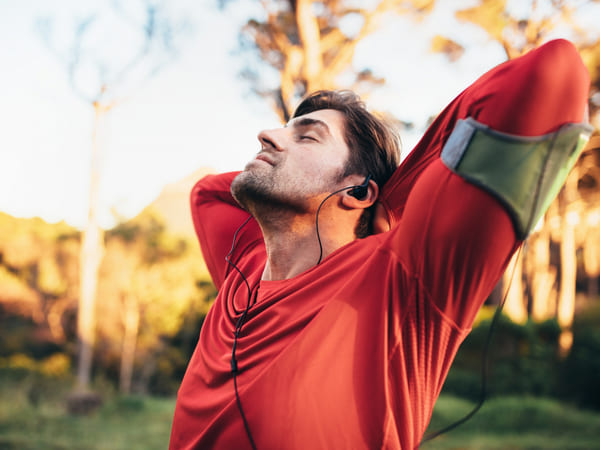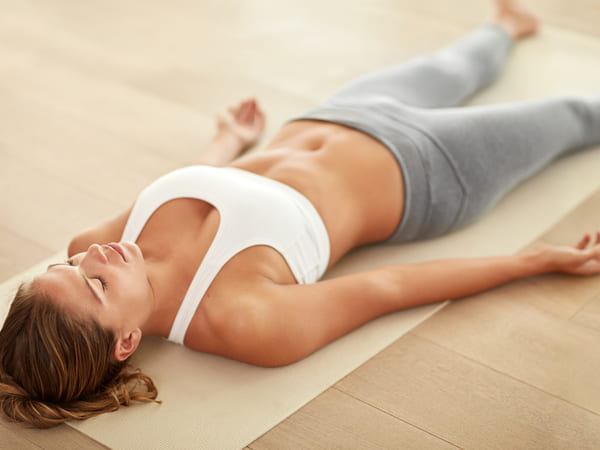HOW TO STRENGTHEN LUNGS AND INCREASE THE OXYGEN LEVELS
If you are a smoker, the best way to strengthen your lungs is to quit smoking. The tar and debris is normally cleared out by the cilia that line the airways - these little hair-like structures work to clear the rubbish out – but these are paralysed and killed by smoking. Stopping smoking gets these working again, so they start to clear the lungs, allowing for better oxygen absorption.
INTRODUCTION
Oxygen is the fuel that powers life on this planet. It’s in the air we breathe, it’s found in water, and we use it to get energy from the food we eat. We extract oxygen from the air in our lungs, and so unhealthy lungs can negatively impact our ability to get oxygen into our bodies.
The question to answer, then, is: ‘what can we do to strengthen the lungs and increase our oxygen levels?’
HOW IMPORTANT ARE STRONG LUNGS FOR YOUR OVERALL HEALTH AND WELLBEING?
Our lungs provide the surface for our bodies to extract oxygen out of the air by diffusion - this is the natural movement of a gas from a high concentration to a low concentration - the high concentration being found in the air we breathe in, and the low concentration found in the blood.
Air is drawn into the lungs by inhaling, and it travels from the mouth down the trachea into the bronchus and then into the smaller bronchioles before making it into the alveoli - the small air sacs in the lungs. The alveoli provide a large surface area for the exchange of oxygen into the blood - and carbon dioxide out of the blood, which is then breathed out!
If the lung function becomes compromised, this will negatively impact the oxygen level in the blood and could also lead to higher levels of carbon dioxide. This results in having less energy, a shortness of breath, and can lead to rapid breathing and confusion.
LUNGS AND OXYGEN LEVELS : WHAT DO YOU NEED TO KNOW?
Oxygen level literally means the amount of oxygen that is circulating in your blood, it is measured using a non-invasive pulse oximeter which is a small device that clips on to the body, typically a finger. By firing small beams of light through the finger, the device can measure the level of oxygen saturation in the blood.
A normal reading for someone with healthy oxygen levels will come out at 95-100%. These readings are technically an estimation, and are normally very accurate, but darker skin tones can impact the tests accuracy. (1)
HOW DO YOU REGULATE OXYGEN LEVELS?
The part of the body responsible for monitoring blood oxygen levels is known as the ‘carotid body’ which can be found in the carotid artery. The carotid body is responsible for monitoring the acidity of the blood, as well as oxygen and carbon dioxide levels.
The cells in the carotid body sense low oxygen levels and send signals to the medulla oblongata - this controls our breathing - to increase the rate of respiration.
There are other factors that can impact the body’s ability to transfer oxygen, with higher cholesterol in red blood cell membranes potentially reducing oxygen diffusion. (2)
The great thing many people can do if they have lower oxygen levels is to engage in some breathing exercises. These can help to increase oxygen levels, as well as improve your general breathing technique!
BREATHING EXERCISES
‘General breathing technique?’ I hear you ask. Does that mean what you think it means? There is indeed a ‘correct’ way to breathe.
According to Mark Courtney from the American Lung Association, you should be breathing in through your nose most of the time as this adds moisture and warms up the air, while also being filtered. (3)
Starting the inhale from the nose, you should then begin ‘belly breathing’ - this is when the diaphragm pulls down, drawing air into the lungs naturally. Exhaling through the mouth is common in many specific breathing exercises, but exhaling through the nose is perfectly normal.
An exercise that can help you to learn this technique is called ‘diaphragmatic breathing’ and is done by lying on your back with knees bent, and by placing a hand on your stomach and one on the chest we can make sure we are engaging the right body parts. Inhale deeply for three seconds, taking care to breathe from the stomach, resulting in the belly and lower ribs rising, but not the chest. Then, tighten the stomach muscles and exhale over six seconds (or so) through tight lips.
Now we’ve covered how you should breathe normally, some specific breathing exercises could come in handy!
INCREASE ENERGY - BELLOW'S BREATH
Sit up and relax the shoulders, keeping the mouth closed, inhale and exhale through the nose with quick, short breaths - do this for 10 seconds. After one round, take thirty seconds of normal breathing then repeat two or three times.
RELAXATION - WIM HOF TECHNIQUE
Lie down or sit, aiming for total relaxation. Breathe in a relaxed manner as deep as you can, and exhale as much as you can through the mouth. Do this thirty times and on the last exhale keep your lungs empty and, staying relaxed, avoid breathing in for as long as you can manage. When you can’t hold any longer, breathe deeply and hold for fifteen seconds, then exhale. That is one round.
For best results, repeat two to three times.
CHRONIC OBSTRUCTIVE PULMONARY DISEASE COPD - PURSED LIP BREATHING
Relax your neck and shoulder muscles as much as possible, then breathe in through the nose for two seconds, keeping the mouth closed - or lips pursed. Breathe out for four seconds through pursed lips. Do this for five to ten minutes, three or four times a day. (4)
Do this while exercising, and try slowing your breathing if suffering a shortness of breath.
A WORD OF CAUTION
These exercises should be done first when you are breathing normally, with practice you will get more comfortable and then you will be able to use them to help when you are short of breath.
LIFESTYLE CHANGES
There are some lifestyle factors that will limit your lung health, no matter how much deep breathing you do. Making some changes to your lifestyle might be the best way to increase lung capacity and improve lung health.
PHYSICAL EXERCISE
Engaging in physical exercise reduces cholesterol levels, increases blood flow to the lungs and increases the capacity of the lungs - these are all great for improving the respiratory system, as well as helping to prevent lung diseases. (5)

QUIT SMOKING
Smoking coats the lungs in tar, preventing the gaseous exchange of oxygen into the blood, and carbon dioxide out of the blood. It also reduces insulin sensitivity, increasing levels of cholesterol in the blood.
Smoking also gets carbon monoxide into the blood - a nasty substance that sticks to red blood cells in the place of oxygen, reducing their ability to transport oxygen around the body.
By quitting smoking, you give your body a chance to get rid of the toxins found in tobacco smoke, like carbon monoxide, while also allowing the lungs to function better - the little hair like structures called ‘cilia’ normally work to clear debris from the lungs, but are paralysed by smoking. These begin to work again!
Using an e-cigarettes is one of the best ways to quit smoking according to the NHS Stop Smoking Service and the Royal College of Physicians.

DIETARY CHANGES
Keeping a healthy diet is another way to make sure your lungs are functioning as best they can. Vitamins and minerals are essential for good immune function, aiding in tackling any lung infections.
Choosing wholegrain carbohydrates is another great addition to your diet - these will provide the daily energy you need while being the healthy option for your heart.
Protein is essential for muscle maintenance, so make sure to consume enough protein to maintain them! The muscles involved in breathing are the diaphragm, the intercostal muscles (muscles between your ribs) and the abdominal muscles (stomach).
Drinking plenty of water is also very important - it helps to produce mucus of the right viscosity (thickness) so that it doesn’t stick too much, and instead is easily moved. Mucus stuck in the lungs or airways is a prime location for developing an infection.

SHOULD YOU SEE A DOCTOR?
Shortness of breath on its own is not necessarily a reason to see a doctor, but if it comes on suddenly and feels severe, affects your ability to function, then you should seek emergency care.
You should also seek emergency care if your shortness of breath is accompanied by chest pain, fainting, nausea, changes in alertness, and blue tinges on the lips or nails.
If your shortness of breath is accompanied by any of the following, then you should make an appointment to see your doctor (6):
Worsening of existing shortness of breath
Wheezing
Fever, chills and cough
Swelling in the feet and/or ankles
Trouble breathing while lying flat
HOW TO STRENGTHEN LUNGS AND INCREASE THE OXYGEN LEVELS - CONCLUSION
Lungs are essential to our existence, so we would all do well to look after them! We need to keep our body supplied with oxygen, and we need to be able to transport it around the body - for that we need strong lungs and high levels of oxygen.
The activities and tips mentioned in this article should help you strengthen your lungs and improve your blood’s oxygen levels, but consider these final tips:
- Open a window, let in the fresh air in and prevent a build up of carbon dioxide in the room.
- Keeping plants inside will help regulate the carbon dioxide levels and improve oxygen levels.
- Drinking warm drinks, or inhaling steam can help to get your airways open, dislodge mucus and aid congestion. A steamy shower, a visit to the steam room or using a humidifier at home are all ways that might help.
For smokers concerned with their lung health, switching to an e-cigarette is a step in the right direction as one study indicates that quitters using E-Cigarettes experience less coughing and phlegm production!
Public Health England’s evidence review concluded e-cigarettes are at least 95% less harmful than traditional cigarettes, and don’t contain tar, so picking up a New SMOKO VAPE POD Stater Kit could be your first step to healthier lungs!
*2024 Update - The largest review of evidence to-date was conducted by Cochrane and found 'high-certainty' evidence that E-Cigarettes are more effective for quitting smoking than traditional forms of nicotine replacement therapy, such as nicotine patches and nicotine gum! (7) Make the switch with SMOKO today!
REFERENCES
(1) Racial Bias in Pulse Oximetry Measurement
(2) Oxygen in Health and Disease: Regulation of Oxygen Homeostasis-Clinical Implications
(3) Five Ways You Might Be Breathing Wrong
(4) COPD and Exercise: Breathing and Exercise Programs for COPD
(5) The Health Benefits of Exercise
(6) Symptoms: Shortness of breath
ABOUT THE AUTHOR
Written by Dan Overgage
Dan Overgage is a former smoker of 10 years until he became a client of SMOKO E-Cigarettes. Dan started working with SMOKO 5 years ago after successfully quitting using our e-cigarettes and works across our Customer Service and heads up our content creation and research with a strong focus on all things quitting smoking. During his tenure with SMOKO, Dan has written countless blogs and consults with countless clients every day to help them to stay smoke-free.














